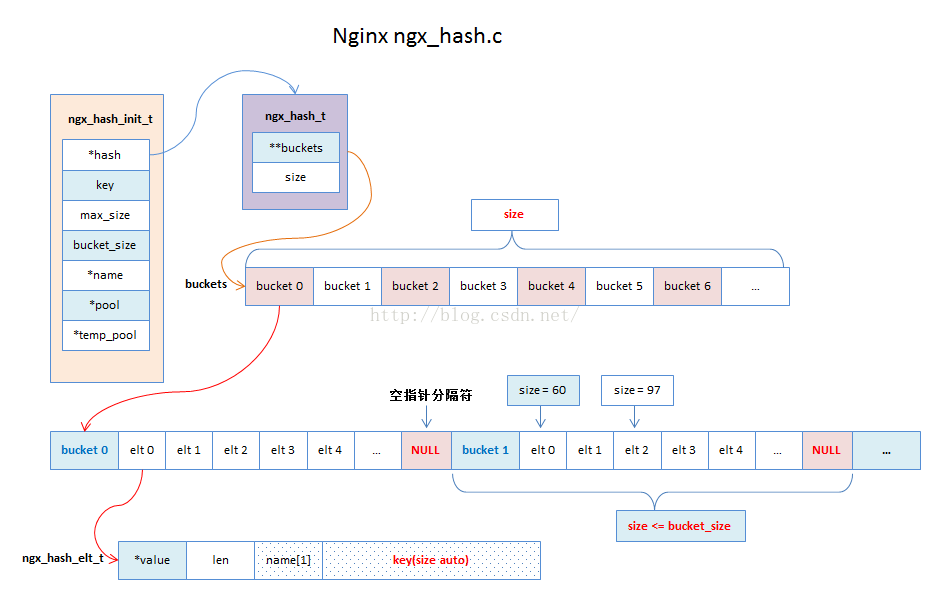哈希表
哈希表是一种典型的以空间换取时间的数据结构,在没有冲突的情况下,对任意元素的插入、索引、删除的时间复杂度都是O(1)。
这样优秀的时间复杂度是通过将元素的key值以hash方法f映射到哈希表中的某一个位置来访问记录来实现的,即键值为key的元素
必定存储在哈希表中的f(key)的位置。当然,不同的元素的hash值可能相同,这就是hash冲突,有两种解决方法(分离链表发和开
放地址发),ngx采用的是开放地址法.
分离链表法是通过将冲突的元素链接在一个哈希表外的一个链表中,这样,找到hash表中的位置后,就可以通过遍历这个单链表来找到这个元素
开放地址法是插入的时候发现自己的位置f(key)已经被占了,就向后遍历,查看f(key)+1的位置是否被占用,如果没被占用,就占用它,
否则继续相后,查询的时候,同样也如果f(key)不是需要的值,也依次向后遍历,一直找到需要的元素。
哈希表的本质
普通哈希表的查找比较简单,思想就是先根据hash值找到对应桶,然后遍历这个桶的每一个元素,逐字匹配是否关键字完全相同,
完全相同则找到,否则继续,直至找到这个桶的结尾(value = NULL)。
nginx的hash表是固定元素长度的,就是一开始已知所有的键值对。无法动态添加,但是可以修改值

gtc_hash_t * gtc_internal_hash_build(unsigned int max_bucket_count
, unsigned int max_bucket_size
, gtc_pool_t *pool
, gtc_hash_key_t *names
, unsigned int nelts)
{
gtc_hash_t * hash = NULL;
unsigned int n = 0, i = 0;
unsigned int *test = NULL;
unsigned int bucket_size = 0, start = 0, index = 0;
unsigned int key = 0, len = 0;
unsigned char *elts = NULL;
gtc_hash_elt_t **buckets = NULL;
gtc_hash_elt_t *elt = NULL;
//1.校验哈希表初始化参数
if (0 == max_bucket_count)
{
//哈希表桶的数目不可以是0
return NULL;
}
if (GTC_MAX_BUCKET_SIZE - GTC_CACHELINE_SIZE < max_bucket_size)
{
//哈希表桶的大小必须小于 GTX_MAX_BUCKET_SIZE
/*
为啥要小于 GTX_MAX_BUCKET_SIZE - GTC_CACHELINE_SIZE?
这是为了内存对齐,因为hash表所有的内存都在内存池上
*/
return NULL;
}
/*
设计说明:
下面操作的目的是为了确认 需要建立哈希表的每一个元素所占内存空间都必须小于 哈希表中桶的大小
hinit->bucket_size < GTC_HASH_ELT_SIZE(&names[n]) + sizeof(void *)说明
hinit->bucket_size 桶的大小
GTC_HASH_ELT_SIZE(&names[n]) 一个哈希元素的大小
sizeof(void *) 哈希表中每个桶都是以NULL结尾
因此 这个 if 判断的意义是 最起码保证 一个桶可以装一个元素(一个桶可以装多个元素,当然更好)
*/
for (n = 0; n < nelts; n++)
{
if (max_bucket_size < GTC_HASH_ELT_SIZE(&names[n]) + sizeof(void *))
{
return NULL;
}
}
do
{
//2.计算出桶的数量
test = (unsigned int *)calloc(max_bucket_count, sizeof(unsigned int));
if (NULL == test)
{
break;
}
/*
设计说明:
a. bucket_size = hinit->bucket_size - sizeof(void *);说明
bucket_size 为实际可以存放元素的大小
hinit->bucket_size - sizeof(void *) 因为每个桶都是NULL结尾,所以实际大小需要 - sizeof(void *)
b. start = nelts / (bucket_size / (2 * sizeof(void *))) + 1;
2 * sizeof(void *) 这个是 gtc_hash_elt_t 最小的值,根据 结构体对齐规则 gtc_hash_elt_t最小就是 2 * sizeof(void *) 大小
bucket_size / (2 * sizeof(void *) 这是桶里最多可以装 多个元素
nelts / (bucket_size / (2 * sizeof(void *))) 计算出最少需要多少个桶
+ 1 为什么需要加1,因为 nelts / (bucket_size / (2 * sizeof(void *))) 本质上是向下取整,最少也应该有一个,所以应该向上取整
*/
bucket_size = max_bucket_size - sizeof(void *); //bucket_size 为实际可以存放元素的大小
start = nelts / (bucket_size / (2 * sizeof(void *))) + 1;
//优化start
if (max_bucket_count > 10000 && nelts && max_bucket_count / nelts < 100)
{
start = max_bucket_count - 1000;
}
//计算出实际桶的数量
for (index = start; index < max_bucket_count; index++)
{
//部分清零策略,提高效率
memset(test, 0x00, (index + 1) * sizeof(unsigned int));
for (n = 0; n < nelts; n++)
{
if (NULL == names[n].key.data)
{
//不处理空数据
continue;
}
//计算当前元素所在桶的位置
key = names[n].key_hash % index;
//计算当前桶的大小
len = test[key] + GTC_HASH_ELT_SIZE(&names[n]);
if (len > bucket_size)
{
//如果当前长度超过桶的最大长度,说明桶的数目不够,需要更加离散
break;
}
test[key] = len;
}
if (n == nelts)
{
//已经找到最合适的桶的数目
break;
}
continue;
}
if (index == max_bucket_count)
{
//当前桶的数量太少,不够存放所有的数据
break;
}
//将每个桶最后的NULL 补上
for (i = 0; i < index; i++)
{
test[i] += sizeof(void *);
}
//计算哈希表的总长度,分配内存空间
len = 0;
for (i = 0; i < index; i++)
{
if (sizeof(void *) == test[i])
{
/*
设计说明:
空桶直接不会分配内存,因为哈希表元素固定且不支持添加
*/
continue;
}
//数字对齐,加快内存检索
test[i] = gtc_align(test[i], GTC_CACHELINE_SIZE);
len += test[i];
}
//创建桶链表
/*
设计说明:
桶里面存储的是 元素的指针,并非元素本身
buckets 的个数一定是 index 个,但是不是每个Index里都有元素的
*/
buckets = gtc_pcalloc(pool, index * sizeof(gtc_hash_elt_t *));
if (NULL == buckets)
{
break;
}
//申请元素内存空间,所有的元素被放置在一块连续的内存上
elts = gtc_pcalloc(pool, len);
if (NULL == elts)
{
break;
}
//指针内存对齐
elts = gtc_align_ptr(elts, GTC_CACHELINE_SIZE);
for (i = 0; i < index; i++)
{
if (sizeof(void *) == test[i])
{
//空桶,跳过
continue;
}
buckets[i] = (gtc_hash_elt_t *)elts;
elts += test[i];
}
//清空探测器,此时test[i] 实际上是 i 这个桶的偏移量
memset(test, 0x00, index * sizeof(unsigned int));
//将元素一一赋值
for (n = 0; n < nelts; n++)
{
if (NULL == names[n].key.data)
{
//空元素不管
continue;
}
//找到桶的位置
key = names[n].key_hash % index;
//找到一个元素块
elt = (gtc_hash_elt_t *)((unsigned char *)buckets[key] + test[key]);
//浅拷贝 value
elt->value = names[n].value;
elt->len = (unsigned short)names[n].key.len;
//字符串拷贝
gtc_strlow(elt->name, names[n].key.data, names[n].key.len);
//更新当前桶偏移
test[key] = (unsigned short) (test[key] + GTC_HASH_ELT_SIZE(&names[n]));
}
for (i = 0; i < index; i++)
{
if (NULL == buckets[i])
{
//空桶不处理
continue;
}
elt = (gtc_hash_elt_t *)((unsigned char *)buckets[i] + test[i]);
//每个桶最后一个元素是 NULL
elt->value = NULL;
}
//哈希表赋值
hash = (gtc_hash_t *)gtc_pcalloc(pool, sizeof(gtc_hash_t));
if (NULL == hash)
{
break;
}
hash->buckets = buckets;
hash->size = index;
} while (0);
//资源释放
if (test)
{
free(test);
test = NULL;
}
return hash;
}
